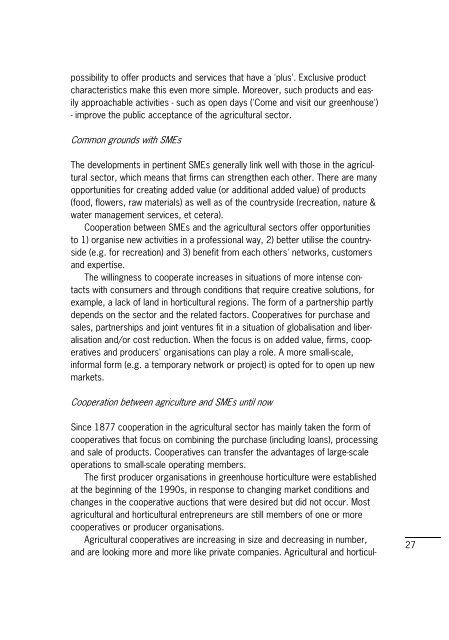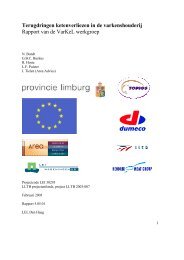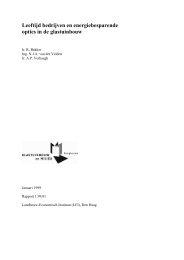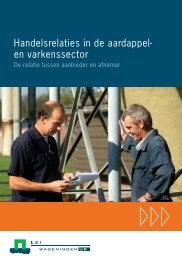2009-082 Samen werken aan samenwerking - Lei
2009-082 Samen werken aan samenwerking - Lei
2009-082 Samen werken aan samenwerking - Lei
Create successful ePaper yourself
Turn your PDF publications into a flip-book with our unique Google optimized e-Paper software.
possibility to offer products and services that have a 'plus'. Exclusive product<br />
characteristics make this even more simple. Moreover, such products and easily<br />
approachable activities - such as open days ('Come and visit our greenhouse')<br />
- improve the public acceptance of the agricultural sector.<br />
Common grounds with SMEs<br />
The developments in pertinent SMEs generally link well with those in the agricultural<br />
sector, which means that firms can strengthen each other. There are many<br />
opportunities for creating added value (or additional added value) of products<br />
(food, flowers, raw materials) as well as of the countryside (recreation, nature &<br />
water management services, et cetera).<br />
Cooperation between SMEs and the agricultural sectors offer opportunities<br />
to 1) organise new activities in a professional way, 2) better utilise the countryside<br />
(e.g. for recreation) and 3) benefit from each others' networks, customers<br />
and expertise.<br />
The willingness to cooperate increases in situations of more intense contacts<br />
with consumers and through conditions that require creative solutions, for<br />
example, a lack of land in horticultural regions. The form of a partnership partly<br />
depends on the sector and the related factors. Cooperatives for purchase and<br />
sales, partnerships and joint ventures fit in a situation of globalisation and liberalisation<br />
and/or cost reduction. When the focus is on added value, firms, cooperatives<br />
and producers' organisations can play a role. A more small-scale,<br />
informal form (e.g. a temporary network or project) is opted for to open up new<br />
markets.<br />
Cooperation between agriculture and SMEs until now<br />
Since 1877 cooperation in the agricultural sector has mainly taken the form of<br />
cooperatives that focus on combining the purchase (including loans), processing<br />
and sale of products. Cooperatives can transfer the advantages of large-scale<br />
operations to small-scale operating members.<br />
The first producer organisations in greenhouse horticulture were established<br />
at the beginning of the 1990s, in response to changing market conditions and<br />
changes in the cooperative auctions that were desired but did not occur. Most<br />
agricultural and horticultural entrepreneurs are still members of one or more<br />
cooperatives or producer organisations.<br />
Agricultural cooperatives are increasing in size and decreasing in number,<br />
and are looking more and more like private companies. Agricultural and horticul-<br />
27

















